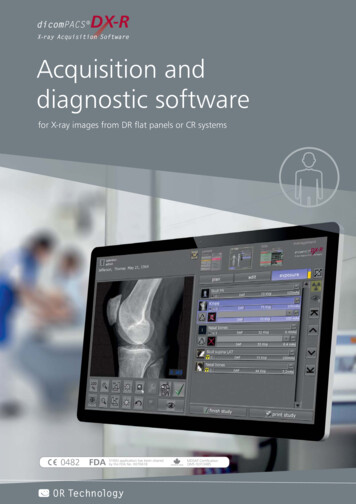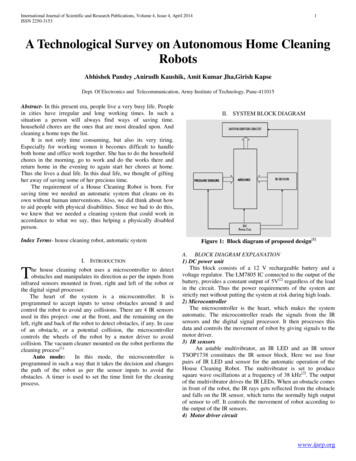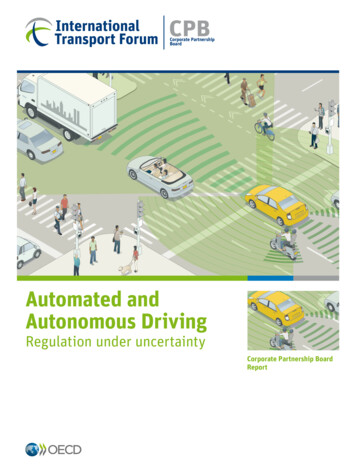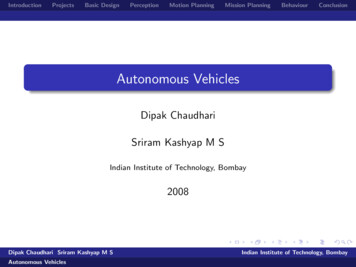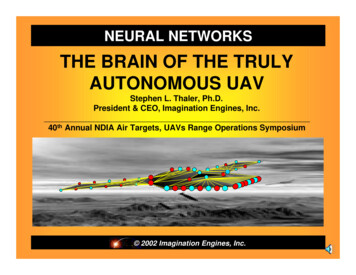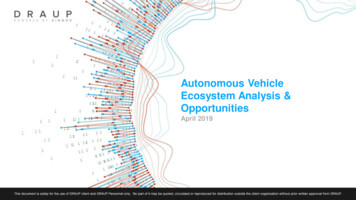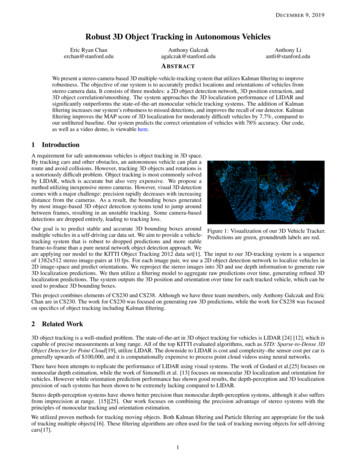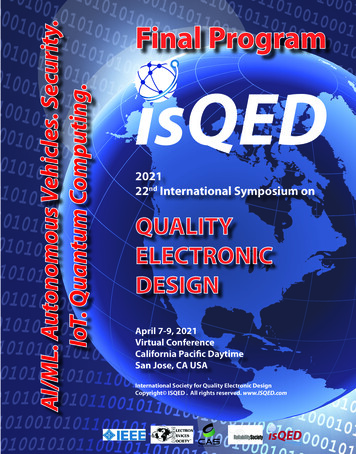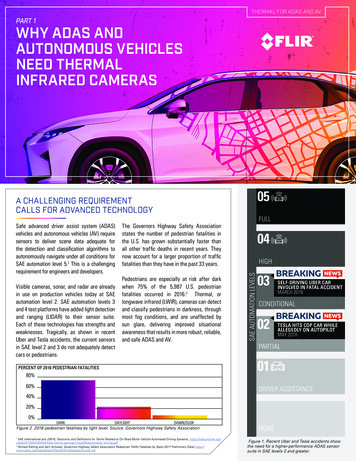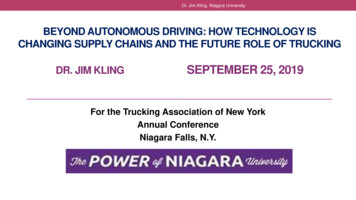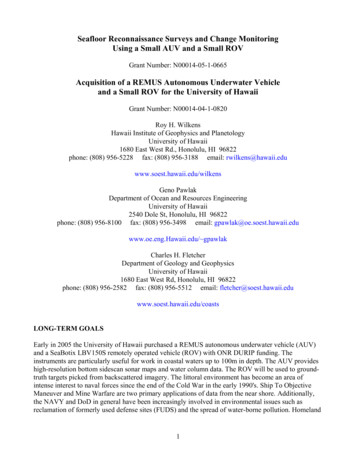
Transcription
Seafloor Reconnaissance Surveys and Change MonitoringUsing a Small AUV and a Small ROVGrant Number: N00014-05-1-0665Acquisition of a REMUS Autonomous Underwater Vehicleand a Small ROV for the University of HawaiiGrant Number: N00014-04-1-0820Roy H. WilkensHawaii Institute of Geophysics and PlanetologyUniversity of Hawaii1680 East West Rd., Honolulu, HI 96822phone: (808) 956-5228 fax: (808) 956-3188 email: o PawlakDepartment of Ocean and Resources EngineeringUniversity of Hawaii2540 Dole St, Honolulu, HI 96822phone: (808) 956-8100 fax: (808) 956-3498 email: gpawlak@oe.soest.hawaii.eduwww.oe.eng.Hawaii.edu/ gpawlakCharles H. FletcherDepartment of Geology and GeophysicsUniversity of Hawaii1680 East West Rd, Honolulu, HI 96822phone: (808) 956-2582 fax: (808) 956-5512 email: tsLONG-TERM GOALSEarly in 2005 the University of Hawaii purchased a REMUS autonomous underwater vehicle (AUV)and a SeaBotix LBV150S remotely operated vehicle (ROV) with ONR DURIP funding. Theinstruments are particularly useful for work in coastal waters up to 100m in depth. The AUV provideshigh-resolution bottom sidescan sonar maps and water column data. The ROV will be used to groundtruth targets picked from backscattered imagery. The littoral environment has become an area ofintense interest to naval forces since the end of the Cold War in the early 1990's. Ship To ObjectiveManeuver and Mine Warfare are two primary applications of data from the near shore. Additionally,the NAVY and DoD in general have been increasingly involved in environmental issues such asreclamation of formerly used defense sites (FUDS) and the spread of water-borne pollution. Homeland1
Form ApprovedOMB No. 0704-0188Report Documentation PagePublic reporting burden for the collection of information is estimated to average 1 hour per response, including the time for reviewing instructions, searching existing data sources, gathering andmaintaining the data needed, and completing and reviewing the collection of information. Send comments regarding this burden estimate or any other aspect of this collection of information,including suggestions for reducing this burden, to Washington Headquarters Services, Directorate for Information Operations and Reports, 1215 Jefferson Davis Highway, Suite 1204, ArlingtonVA 22202-4302. Respondents should be aware that notwithstanding any other provision of law, no person shall be subject to a penalty for failing to comply with a collection of information if itdoes not display a currently valid OMB control number.1. REPORT DATE3. DATES COVERED2. REPORT TYPE30 SEP 200500-00-2005 to 00-00-20054. TITLE AND SUBTITLE5a. CONTRACT NUMBERSeafloor Reconnaissance Surveys and Change Monitoring Using a SmallAUV and a Small ROV5b. GRANT NUMBER5c. PROGRAM ELEMENT NUMBER6. AUTHOR(S)5d. PROJECT NUMBER5e. TASK NUMBER5f. WORK UNIT NUMBER7. PERFORMING ORGANIZATION NAME(S) AND ADDRESS(ES)University of Hawaii,Hawaii Institute of Geophysics and Planetology,1680East West Rd,Honolulu,HI,968229. SPONSORING/MONITORING AGENCY NAME(S) AND ADDRESS(ES)8. PERFORMING ORGANIZATIONREPORT NUMBER10. SPONSOR/MONITOR’S ACRONYM(S)11. SPONSOR/MONITOR’S REPORTNUMBER(S)12. DISTRIBUTION/AVAILABILITY STATEMENTApproved for public release; distribution unlimited13. SUPPLEMENTARY NOTEScode 1 only14. ABSTRACTEarly in 2005 the University of Hawaii purchased a REMUS autonomous underwater vehicle (AUV) and aSeaBotix LBV150S remotely operated vehicle (ROV) with ONR DURIP funding. The instruments areparticularly useful for work in coastal waters up to 100m in depth. The AUV provides high-resolutionbottom sidescan sonar maps and water column data. The ROV will be used to ground-truth targets pickedfrom backscattered imagery. The littoral environment has become an area of intense interest to navalforces since the end of the Cold War in the early 1990’s. Ship To Objective Maneuver and Mine Warfareare two primary applications of data from the near shore. Additionally, the NAVY and DoD in generalhave been increasingly involved in environmental issues such as reclamation of formerly used defense sites(FUDS) and the spread of water-borne pollution. Homeland security also has a stake in understanding andmonitoring coastal shallow waters. Our long term goal is to develop the expertise to easily deploy our assetsin the field for economical and rapid data reduction and assessment of areas of interest to the Navy, othergovernmental agencies, and the research community.15. SUBJECT TERMS16. SECURITY CLASSIFICATION OF:a. REPORTb. ABSTRACTc. THIS PAGEunclassifiedunclassifiedunclassified17. LIMITATION OFABSTRACT18. NUMBEROF PAGESSame asReport (SAR)719a. NAME OFRESPONSIBLE PERSONStandard Form 298 (Rev. 8-98)Prescribed by ANSI Std Z39-18
security also has a stake in understanding and monitoring coastal shallow waters. Our long term goal isto develop the expertise to easily deploy our assets in the field for economical and rapid data reductionand assessment of areas of interest to the Navy, other governmental agencies, and the researchcommunity.OBJECTIVESObjectives during the past year were to(1) adapt custom sidescan sonar software used by the Hawaii Mapping Research Group (HMRG) foruse with REMUS data,(2) begin a time series of sidescan surveys off Kakaako (Oahu) around the Kilo Nalu Cabled ReefObservatory, and(3) develop techniques to ground truth targets seen in sidescan surveys with the ROV.APPROACHRaw data from the sidescan system aboard the REMUS is translated into a standard HMRG format.Data are then processed to form mosaics of bottom sidescan. Both raw and processed data areexamined for the location of man-made targets and to characterize sand texture. Targets are thenexamined using the ROV. Repeat surveys will be done on a monthly basis and/or before and afterstorm events. Objects will be placed on the seafloor in sandy areas to document scour and burial overtime.WORK COMPLETEDAlgorithms to reformat raw REMUS sidescan data have been written. We are in the process of writingbatch processing scripts that will allow rapid initial looks at seafloor mosaics. HYDROID suppliessoftware to look at individual data files that are useful for target identification, but the files are notgeographically registered. Now that we have access to HMRG software we continue to hone our datareduction skills. By adapting HMRG codes, we also have the added benefit of free access to theHMRG programmers and the potential for REMUS-specific processing adaptations in the future.The area around Kilo Nalu was surveyed during REMUS training in March, 2005. We then underwenta pause in operations while we organized insurance for the vehicle and developed the software. Asecond Kilo Nalu survey was conducted in September - meant to be the first of the time series. TheREMUS experienced a total systems failure about 45 minutes into the mission. We were able torecover it (floating dead on the surface - no transponder) and it is currently being shipped toHYDROID for troubleshooting and repair.2
RESULTSA target picked out of the March, 2005, data is shown in Figure 1. We used REMUS software toidentify the location of the target and then visited it with our ROV. A still frame for the ROV video isalso shown in Figure 1 (a video clip is available at www.soest.hawaii.edu/wilkens/targets). At least inHawaiian waters, where visibility is generally good, finding sidescan targets with the ROV is fairlysimple.There were some data collected in September before REMUS failed. A comparison of images of thesame section of seafloor in March and September is shown in Figure 2. These images are not plotted ingeographic coordinates, but rather are referenced to the AUV. The main contrast between the images isin the sandy arras. In March the sand was covered in ripples, including an interesting herringbonepattern (lower right). In September the ripples were not present. Other areas (not illustrated) suggestthat the sand may have been a little deeper during the earlier survey as well. What we do not know atthis time is whether the differences we see are seasonal or related to the wave climate immediatelybefore each survey. Repeated surveys will answer those questions once REMUS is returned to duty.An example of a section of mosaic from the March data is presented in Figure 3. In this instance bothport and starboard swaths have been incorporated to give full coverage. Doing this means that someareas are illuminated from the southeast while others are illuminated from the northwest. Future repeatsurveys will be done at close enough intervals that 2 separate mosaics can be formed - one from eachlook direction. The sand field with herringbone ripples illustrated in Figure 2 is just above the "X" inFigure 3.IMPACT/APPLICATIONSWe have introduced the combined REMUS and LBV 150 system to the local office of the US ArmyCorps of Engineers. They have shown a great deal of interest in using the equipment to survey forunexploded ordnance off Oahu and the island of Hawaii. We had scheduled 2 weeks on Hawaii inOctober to perform some preliminary work, but will be delayed until December due to the REMUStechnical problems.RELATED PROJECTSSand Distribution and Statistical Spatial Characteristics on Pacific Reef Platforms. Charles Fletcher P.I. We will be using the techniques and software developed in this project to map sand deposits over awide area of Oahu coastline. www.soest.hawaii.edu/coasts/cgg main.htmlWave Boundary Layer Processes Over an Irregular Bottom. Geno Pawlak -P.I. The Kilo Naluobservatory is recording environmental data in the area where we will be doing the time seriesobservations, providing us with inputs to models of ripple development as we begin to build a data set.oe.eng.hawaii.edu/ gpawlak/index.html3
Figure 1. Upper left - a rectangular target seen in a section of sidescan data from the REMUS AUV.Object is approximately 1.0 X 0.5 X 0.5 m. Upper right - detail of object from sidescan data. Imagesuggests an open framework texture. Bottom - still frame from ROV video of sidescantarget showing4
Figure 2. Top - section of sidescan data collected in March, 2005. These data have been processedto remove the nadir line, but have not been converted to a geographic coordinate system. The imageshows parts of a coral reef and a sand field to the right that is crosshatched with ripples. Bottom the same section of seafloor from a sidescan survey done in September, 2005. The sandy portion ofthe image does not have the rippled pattern seen in earlier data. Images are 60 X 150 m.5
XFigure 3. A section of sidescan mosaic from the March, 2005 mission. The sidescan image showsboth reef and sand fields. The area examined in Figure 2 is above the X in the center of the mosaic.6
a pause in operations while we organized insurance for the vehicle and developed the software. A second Kilo Nalu survey was conducted in September - meant to be the first of the time series. The REMUS experienced a total systems failure about 45 minutes into the mission. We were able to recover it (floating dead on the surface - no transponder) and it is currently being shipped to HYDROID for .
